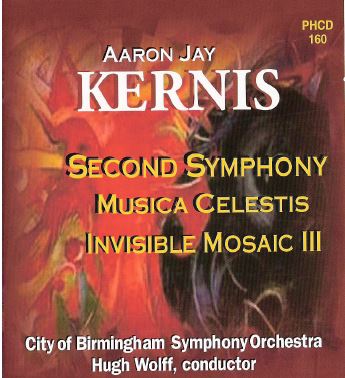
AARON JAY KERNIS works for orchestra
PHCD160 | Phoenix CD
| Name | Credit | |
|---|---|---|
 |
Aaron Jay Kernis | Composer |
 |
Hugh Wolff | Conductor |
SYMPHONY NO.2
MUSICA CELESTIS
INVISIBLE MOSAIC III

PHCD160 | Phoenix CD
| Name | Credit | |
|---|---|---|
 |
Aaron Jay Kernis | Composer |
 |
Hugh Wolff | Conductor |
While working on the Second Symphony, Kernis recalls the collective national fixation on images of the 1991 Persian Gulf War. For the composer, these “exerted a kind of fascination and sense of horror at what seemed to be a purely technological war, one that was heavily manipulated by the government for the media.” One specific image that haunted Kernis came from the cover of The New York Post, which documented the accidental bombing of an apartment building in Iraq. “Something about the immediate annihilation without warning gave me the sonic image of pulverizing and obliteration” an image with which the Symphony reaches its climax.
Kernis describes an overarching narrative structure to the three-movement work, centered on a metaphor of humanity facing the brutalizing machine: “The work is very linear, with the long line put forward in three different contexts in each movement. In the first, the line is set against an unyielding mechanical, rhythmic profile, giving the sense of a wave threatening to overtake the melody. The second movement winnows essentially to melody and accompaniment (with some areas of counterpoint), while in the third the stark line is mostly exposed alone against the wave of percussion. Equally important is the gradual stripping away of layers as the piece goes on.”
The String Quartet No. 1 takes its name from the subtitle of its slow second movement: “musica celestis.” This is also the name Kernis applies to what has become perhaps his best-known work to date. In the tradition of Samuel Barber’s similarly extracted Adagio for Strings, Musica Celestis is an arrangement of that Quartet movement for string orchestra (with double bass added), completed in 1991. Kernis ascribes his inspiration to the medieval concept of the music of the spheres, “which refers to the singing of the angels in heaven in praise of God without end.” He cites his discovery of Hildegard of Bingen, yet Musica Celestis evinces a broader range of influences: from English pastoralism and the Barber Adagio to the radical simplicity of Beethoven’s Heiliger Dankgesang from Op.132 all framed by a sonority reminiscent of Lohengrin’s “silvery blue” A major harmonies.